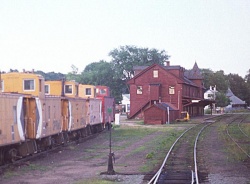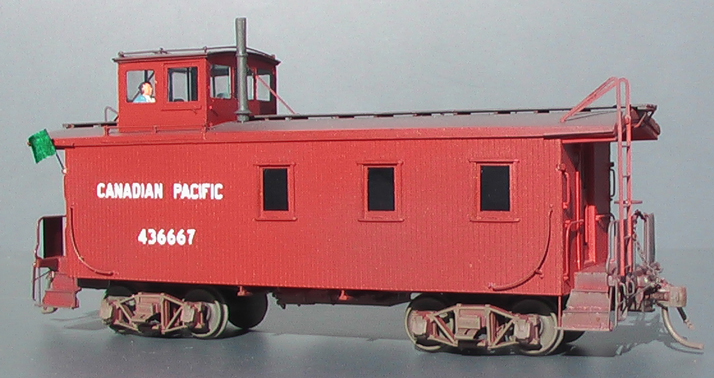Dominion Atlantic Railway Digital Preservation Initiative - Wiki
Use of this site is subject to our Terms & Conditions.
Difference between revisions of "Category:Vans"
Dan Conlin (talk | contribs) (date) |
|||
| Line 2: | Line 2: | ||
[[Image:KentvilleStationi.jpg|thumb|250px|right|CP Vans at the [[Kentville Station]], circa 1988.]] | [[Image:KentvilleStationi.jpg|thumb|250px|right|CP Vans at the [[Kentville Station]], circa 1988.]] | ||
| − | === | + | |
| + | |||
| + | ==C.P.R. Wooden Van with Tall Cupola== | ||
| + | CPR’s classic wood caboose design goes back to about 1905. Many series were built until 1945 with the same basic dimensions. Construction technics changed over the years and many were modernized in 1960’s and 70’s with plywood sides. Beginning in 1912 steel center sills were used. In the side were three windows and the cupola had eight windows. In the mid 1920’s the end beams were beefed up and one side window in the cupola was sheeted over. During the depression (1930’s) no new cabooses were built, but existing ones were rebuilt. The third side window was removed and the center window in the cupola end was sheeted over. Most received storm doors to keep out the draft and the inside warmer in the wintertime. The roof was now painted black and the side numbers reduced in size. For safety reasons the steps were changed for longer ones and the end railings heightened. | ||
| + | |||
| + | Traffic increase in WW2 faced CP with a shortage of cabooses, because no new cabooses were built since 1929. Beginning in 1941 new ones were built to the old design but they had welded double beam center sills and steel end beams. After 1943 the truck centers were increased by one foot. Hand rails and grabs were painted yellow during WW2. All CP wooden cabooses were built with tongue and grove siding. | ||
| + | |||
| + | Starting in 1960’s CP rebuilt many with plywood sides. On some the plywood was nailed over the tongue and grove siding, on others the T&G siding was removed before the plywood was nailed on. Some had their wooden end beams replaced with ones made from steel. From 1959 on the script logo was used, after 1968 the CP Rail logo was put on. | ||
| + | In the early 1970’s they were painted yellow and the roof walks and ladders were removed. All wooden cabooses were removed from service in the early 1980’s. | ||
| + | |||
<Gallery> | <Gallery> | ||
| − | Image: | + | [[Image:Heritage Railway CPR Van a.jpg|Heritage Railway Miniatures C.P.R. Wooden Van]] |
| − | + | [[Image:Heritage Railway CPR Van b.jpg|Heritage Railway Miniatures C.P.R. Wooden Van]] | |
| + | [[Image:Heritage Railway CPR Van c.jpg|Heritage Railway Miniatures C.P.R. Wooden Van]] | ||
| + | </Gallery. | ||
| + | |||
| + | [[Image:Heritage Railway CPR Van a.jpg|thumb|250px|left|Heritage Railway Miniatures C.P.R. Wooden Van]] | ||
| + | [[Image:Heritage Railway CPR Van b.jpg|thumb|250px|center|Heritage Railway Miniatures C.P.R. Wooden Van]] | ||
| + | [[Image:Heritage Railway CPR Van c.jpg|thumb|250px|right|Heritage Railway Miniatures C.P.R. Wooden Van]] | ||
[[Category:Mow]] | [[Category:Mow]] | ||
Revision as of 16:09, 6 November 2008
Dominion Atlantic Railway Vans

C.P.R. Wooden Van with Tall Cupola
CPR’s classic wood caboose design goes back to about 1905. Many series were built until 1945 with the same basic dimensions. Construction technics changed over the years and many were modernized in 1960’s and 70’s with plywood sides. Beginning in 1912 steel center sills were used. In the side were three windows and the cupola had eight windows. In the mid 1920’s the end beams were beefed up and one side window in the cupola was sheeted over. During the depression (1930’s) no new cabooses were built, but existing ones were rebuilt. The third side window was removed and the center window in the cupola end was sheeted over. Most received storm doors to keep out the draft and the inside warmer in the wintertime. The roof was now painted black and the side numbers reduced in size. For safety reasons the steps were changed for longer ones and the end railings heightened.
Traffic increase in WW2 faced CP with a shortage of cabooses, because no new cabooses were built since 1929. Beginning in 1941 new ones were built to the old design but they had welded double beam center sills and steel end beams. After 1943 the truck centers were increased by one foot. Hand rails and grabs were painted yellow during WW2. All CP wooden cabooses were built with tongue and grove siding.
Starting in 1960’s CP rebuilt many with plywood sides. On some the plywood was nailed over the tongue and grove siding, on others the T&G siding was removed before the plywood was nailed on. Some had their wooden end beams replaced with ones made from steel. From 1959 on the script logo was used, after 1968 the CP Rail logo was put on. In the early 1970’s they were painted yellow and the roof walks and ladders were removed. All wooden cabooses were removed from service in the early 1980’s.
Pages in category "Vans"
The following 34 pages are in this category, out of 34 total.
D
- DAR000003
- DAR000004
- DAR000091
- DAR000092
- DAR000093
- DAR000094
- DAR000095
- DAR000096
- DAR000097
- DAR000098
- DAR000099
- DAR434038
- DAR434061
- DAR434676
- DAR434678
- DAR435398
- DAR435459
- DAR435730
- DAR435786
- DAR435797
- DAR435922
- DAR436617
- DAR436994
- DAR436997
- DAR436998
- DAR437068
- DAR437130
- DAR437131
- DAR437210
- DAR437223
- DAR437245
- DAR437293
- DAR437484
- DAR437496
Media in category "Vans"
This category contains only the following file.
- STR-18280 - 435730.jpg 750 × 441; 117 KB






